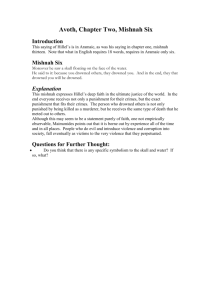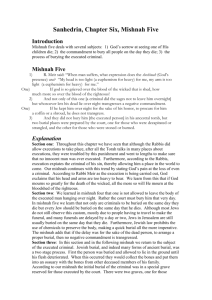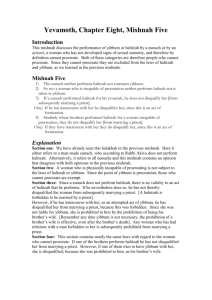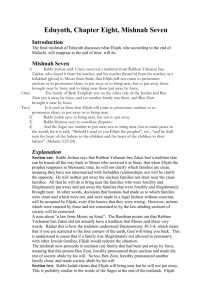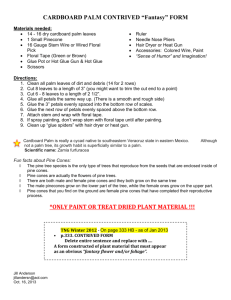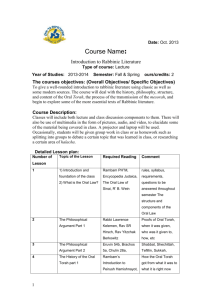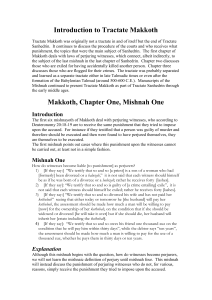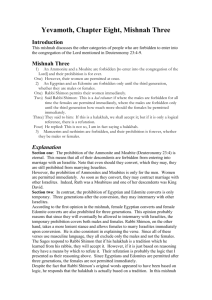In a 1998 article in the journal Sinai, Ilana Katzenellenbogen
advertisement
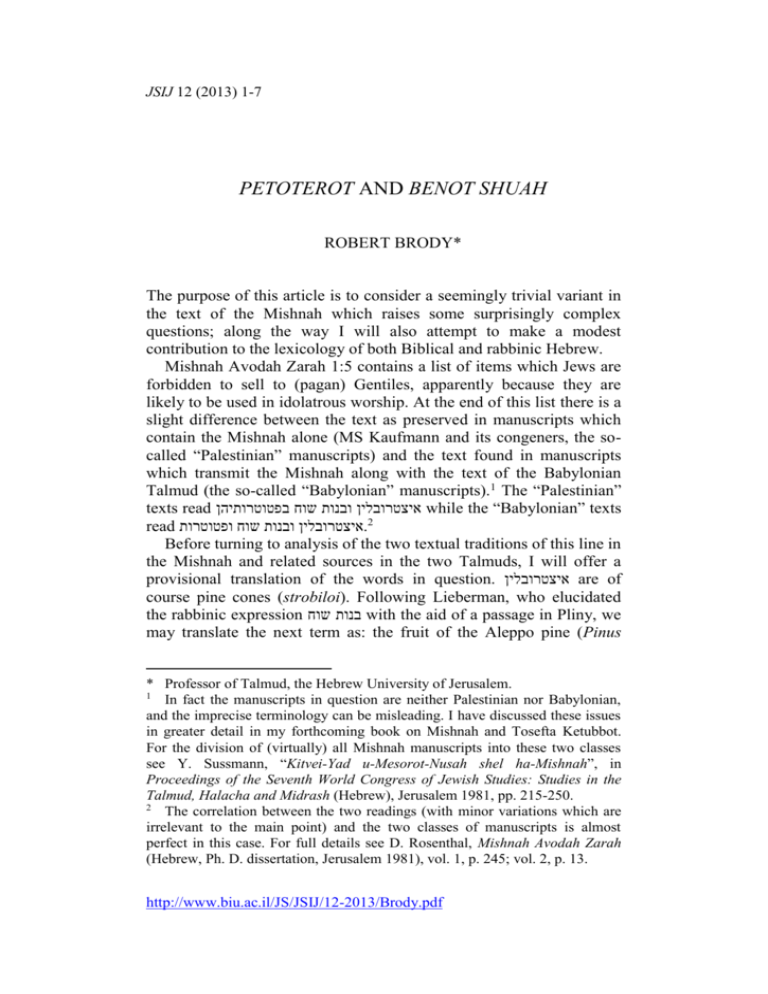
JSIJ 12 (2013) 1-7 PETOTEROT AND BENOT SHUAH ROBERT BRODY* The purpose of this article is to consider a seemingly trivial variant in the text of the Mishnah which raises some surprisingly complex questions; along the way I will also attempt to make a modest contribution to the lexicology of both Biblical and rabbinic Hebrew. Mishnah Avodah Zarah 1:5 contains a list of items which Jews are forbidden to sell to (pagan) Gentiles, apparently because they are likely to be used in idolatrous worship. At the end of this list there is a slight difference between the text as preserved in manuscripts which contain the Mishnah alone (MS Kaufmann and its congeners, the socalled “Palestinian” manuscripts) and the text found in manuscripts which transmit the Mishnah along with the text of the Babylonian Talmud (the so-called “Babylonian” manuscripts).1 The “Palestinian” texts read איצטרובלין ובנות שוח בפטוטרותיהןwhile the “Babylonian” texts read איצטרובלין ובנות שוח ופטוטרות.2 Before turning to analysis of the two textual traditions of this line in the Mishnah and related sources in the two Talmuds, I will offer a provisional translation of the words in question. איצטרובליןare of course pine cones (strobiloi). Following Lieberman, who elucidated the rabbinic expression בנות שוחwith the aid of a passage in Pliny, we may translate the next term as: the fruit of the Aleppo pine (Pinus * Professor of Talmud, the Hebrew University of Jerusalem. 1 In fact the manuscripts in question are neither Palestinian nor Babylonian, and the imprecise terminology can be misleading. I have discussed these issues in greater detail in my forthcoming book on Mishnah and Tosefta Ketubbot. For the division of (virtually) all Mishnah manuscripts into these two classes see Y. Sussmann, “Kitvei-Yad u-Mesorot-Nusah shel ha-Mishnah”, in Proceedings of the Seventh World Congress of Jewish Studies: Studies in the Talmud, Halacha and Midrash (Hebrew), Jerusalem 1981, pp. 215-250. 2 The correlation between the two readings (with minor variations which are irrelevant to the main point) and the two classes of manuscripts is almost perfect in this case. For full details see D. Rosenthal, Mishnah Avodah Zarah (Hebrew, Ph. D. dissertation, Jerusalem 1981), vol. 1, p. 245; vol. 2, p. 13. http://www.biu.ac.il/JS/JSIJ/12-2013/Brody.pdf 2 Robert Brody halepensis) or stone-pine (Pinus pinea).3 And, as Lieberman remarked, the context supports the interpretation of the last word offered by early authorities, “stalks”.4 Thus, we may translate the line in question as “pine cones, Aleppo pine (or stone–pine) cones and stalks (or, according to the alternative version: with their stalks)”. I would add that the interpretation of petoterot as stalks is supported not only by the context but by etymological considerations: like שפופרתand perhaps מטוטלת, this is a noun formed by reduplication of the second radical in the underlying trilateral root, in this case פטר. This root appears in botanical contexts in the problematic expression פטורי צצים, which appears numerous times in the description of the decoration of Solomon’s Temple in I Kings 6 but nowhere else, as well as in rabbinic Hebrew ‘ פטריהmushroom’; in my opinion there is an etymological connection between plant growth and flowing water (see Proverbs 17:14), as exemplified by Biblical Hebrew shibboleth, which refers both to part of a river (Isaiah 27:12, cf. Psalms 69:16) and, more commonly, to a stalk or ear of grain, as well as by the root שלחwhich is used both of allowing water to flow (Job 12: 15) and of plant growth (as in Jeremiah 17:8, Ezekiel 31: 5, Psalms 80: 12, and cf. Isaiah 16: 8). S. Lieberman, “Palestine in the Third and Fourth Centuries”, JQR n.s. 36 (1946), 329-370; 37 (1946-1947), 31-54; the relevant passage for our purposes is vol. 37, pp. 47-51 (cited by Rosenthal, p. 245). I would, however, depart slightly from Lieberman, see the appendix below. Lieberman’s discussion confused Rosenthal, see n.11 below. Y. Feliks in his edition of Talmud Yerushalmi: Massekhet Shevi‛it2 (Jerusalem 2000, I, pp. 299-300) essentially followed Lieberman but pointed out that the identification with Pinus pinea is preferable both because its growth pattern conforms more closely to that described in Mishnah Shevi‛it 5:1 and because the seeds of Pinus halepensis are only minimally edible, although, on the assumption that איצטרובליןare specifically cones of Pinus pinea, he was troubled by the apparent duplication in our mishnah. In another publication (Atzei Peri le-Mineihem: Tzimhei ha-TaNaKh ve-HaZaL, Jerusalem 1994, p. 178 and n. 11) he offered the highly implausible suggestion that both איצטרובלין and benot shuah referred to Pinus pinea but to different parts of the plant: איצטרובליןwould be the intact cones, while benot shuah would refer both to the seeds and to the tree, and petoterot to cones from which the seeds had been removed. Perhaps benot shuah, which appears more frequently in rabbinic literature as a food item, should be identified with the fruit of Pinus pinea, and איצטרובליןwith the fruit of Pinus halepensis? 4 Ibid., p. 47 n. 44. 3 http://www.biu.ac.il/JS/JSIJ/12-2013/Brody.pdf Petoterot and Benot Shuah 3 At first glance it appears that the Babylonian Talmud confirms that the reading בפטוטרותיהן, “with their petoterot”, is a Palestinian version of this mishnah, as R. Yohanan is quoted by Rabbah bar bar Hannah as saying בפטוטרותיהן שנו, “they recited: ‘with their petoterot’.”5 However, as Epstein pointed out, the style שנו... בindicates an interpretation (restricting the mishnah’s statement to a particular set of circumstances) rather than an emendation or textual decision, so this source actually implies that R. Yohanan’s version of the mishnah did not include the word ( בפטוטרותיהןat least not in this form, see below).6 Furthermore, the Palestinian Talmud, in the name of a different tradent, reports a somewhat different version of R. Yohanan’s dictum:7 שמעון בר בא בשם ר' יוחנן בנות שוח בפטוטרותיהן ואיצטרובילין במטוטלותיהן. On the face of it this citation would seem to imply that the word פטוטרות, like the word מטוטלותwhich is not found in any text of the mishnah, was added by R. Yohanan by way of interpretation. On the basis of these two sources, Epstein posits that the mishnah as late as R. Yohanan’s time did not include the word petoterot at all, whether in the “Babylonian” or the “Palestinian” form. In his opinion, this word was added to the text of the mishnah in the wake of R. Yohanan’s comment, originally in the form preserved in the “Palestinian” branch of the tradition, and later in the corrupt form found in the “Babylonian” branch.8 This suggestion is quite problematic, as pointed out by Rosenthal: It is hard to imagine that a gloss which entered the mishnah at such a late date (mid-3rd century CE at the earliest) would be found in all its textual witnesses and traditions.9 Rosenthal proposes an alternative which is even more problematic: according to him, the expression benot shuah in this mishnah refers to the wood of the tree rather than its fruit, and petoterot is a corruption of a Greek gloss on this expression which should read petudia.10 This interpretation is to be rejected for numerous reasons, among them the context which implies that benot shuah are sacrificial items like the others in the list, rather 5 BT Avodah Zarah 14a. According to MSS Paris 1337 and New York Rab. 15, Rabba bar bar Hannah is the author of this dictum; in MS New York “said R. Yohanan” is added above the line. 6 J. N. Epstein, Mavo le-Nusah ha-Mishnah, Jerusalem 1948, p. 974. 7 Avodah Zarah 1:5, 39d, column 1379 in the Academy of the Hebrew Language edition. 8 Epstein (n. 6 above), ibid. 9 Rosenthal (n. 2 above), p. 247. 10 Ibid., pp. 246-247. http://www.biu.ac.il/JS/JSIJ/12-2013/Brody.pdf 4 Robert Brody than wood used as fuel for the altar; the unlikelihood of a Greek gloss on a relatively common Hebrew expression entering all known textual traditions of the mishnah; and the even greater implausibility of it doing so in a corrupt form involving reduplication of the t and a graphic error of r for d.11 The more original version of this mishnah is almost certainly preserved in the “Babylonian” manuscripts, while the “Palestinian” manuscripts, presumably influenced by R. Yohanan’s comment in one form or another, emended “and petoterot” to “with their petoterot”.12 In terms of content, however, there is not necessarily any conflict between the two readings: the “Babylonian” version could be understood as if petoterot were a separate item in the list of items which it was forbidden to sell to Gentiles, but there is no need to interpret it in this manner – “pine cones and stalks” could mean “pine cones with their stalks” (as we might say that a meal included “hot dogs and buns”). Thus the comment of Rabbah bar bar Hannah in the name of R. Yohanan would not represent a rejection of this version of the mishnah in favor of one which read בפטוטרותיהן, but merely an assertion that the ambiguous expression “and petoterot” should be understood as “with their petoterot”.13 The mishnah would then 11 Aside from any other difficulties, the proposed corruption d > r makes sense only if we assume that the Mishnah was transmitted at a very early stage in writing, an opinion held by Epstein but rejected by Lieberman and by the later scholarly consensus (see for example: Y. Sussmann, “Torah shebe-al Peh Peshutah ke-Mashma’ah – Koho shel Qotzo shel Yod”, Mehqerei Talmud, III, Jerusalem 2005, pp. 209-384, especially 212-224). Rosenthal’s suggestion is also based on a misunderstanding of Lieberman as having interpreted benot shuah in our mishnah as referring to the wood rather than the fruit of the Aleppo pine or stone-pine (see notes 3-4 above and Rosenthal pp. 246-247). Lieberman believed this expression could refer either to the wood or to the fruit (see the appendix below), and in this particular case understood correctly that it refers to the fruit. 12 In this respect I agree with Rosenthal (p. 247) against Epstein (n. 6 above). Conceivably the transmitters of the “Palestinian” branch of the Mishnah might have been familiar with a version of this comment different from those preserved in either the PT or the BT, e.g. כיני מתניתא בפטוטרותיהן, since this term is used in PT both for interpretations and for textual decisions; see Epstein, op. cit., pp. 441-508. 13 If we take the first letter of בפטוטרותיהןas part of the complex term שנו...ב, the dictum would mean that the mishnah does not refer to unspecified petoterot (in which case we would understand them as a separate item) but to “their petoterot”, i.e. the stalks of the pine cones mentioned immediately before, in which case we would understand the mishnah to mean “with their petoterot”. http://www.biu.ac.il/JS/JSIJ/12-2013/Brody.pdf Petoterot and Benot Shuah 5 indicate that pine cones without their stalks would have been considered incomplete and therefore inappropriate sacrificial objects.14 As for the version of R. Yohanan’s dictum transmitted by the Palestinian Talmud, בנות שוח בפטוטרותיהן ואיצטרובילין במטוטלותיהן, I would suggest that it makes several points: (1) as in the version transmitted by the Babylonian Talmud, “and stalks” should be understood as “with their stalks”; (2) this requirement applies not only to the item immediately preceding the word “petoterot”, namely stone-pine or Aleppo pine cones, but also to the preceding item, generic pine cones; (3) while “petoterot” is the right word for stalks of these particular varieties of pine, a different word, “metotelot”, is the more appropriate term for the stalks of generic pine cones. APPENDIX: BENOT SHUAH It appears that Lieberman took the expression benot shuah to refer both to a particular type of tree (a diminutive Aleppo pine or stonepine) and to its fruit, although he did not always express himself clearly on this point. In his article, and even more so a decade later in his Tosefta commentary, he emphasized his identification of this expression with a particular type of pine tree rather than its fruit.15 But in the case of Mishnah Avodah Zarah he clearly states: “Our Mishnah thus lists three articles used by the heathen in their idol worship: the cones of two kinds of pines, the white cock and frankincense.”16 I would argue that shuah refers specifically to the tree17 and benot shuah to the fruit (unlike words such as tamar, te’enah, haruv which refer indiscriminately to a type of tree and to its fruit). Benot shuah clearly refers in some contexts, including the mishnah in Avodah Zarah as well as Mishnah Demai 1:1 and the baraita quoted in the Babylonian Talmud, Nedarim 26b-27a, to the fruit, and I have not found any source in which it appears to refer specifically to the tree; the lone instance I have found of benot shikmah in Mishnah Demai Alternatively, the bet may not be part of this term, and the dictum should be understood as “they taught: with their petoterot”; ultimately, these interpretations produce the same result in terms of understanding the mishnah. 14 Cf. Lieberman, op. cit., pp. 50-51 and n. 64. 15 See JQR 37, especially pp. 48, 50, and Tosefta ki-Peshutah, I (New York 1955), pp. 132-133. 16 JQR ibid., p. 50, and cf. ibid., p. 47 n. 44, cited above. 17 As in the Aramaic version of the Testaments of the Twelve Patriarchs cited by Lieberman, ibid., p. 48. http://www.biu.ac.il/JS/JSIJ/12-2013/Brody.pdf 6 Robert Brody ibid. also clearly refers to the fruit and not the wood of the sycamore tree.18 The idiom is comparable to banat al-ard in Arabic and bnt šdm in Ugaritic, and the etymological development is the obverse of the one which yields פרי בטןin Biblical Hebrew. The Greek diminutive form, which Lieberman understood to refer to small trees,19 can also be used to refer to the fruit of a given species of tree, as in the cases of pistake (pistachio tree), pistakion (pistachio) and kerasos (cherry tree), kerasion (cherry);20 I would like to thank Daniel Schwartz who clarified this point for me. Lieberman refers to R. Yohanan’s comment, quoted twice in the Babylonian Talmud (Berakhot 40b and Avodah Zarah 14a) that benot shuah are “white figs”,21 and says that he demonstrated in his article that this expression refers “not to the fruit but to the tree itself, that is to say, the tree is called a white fig.” Furthermore, he asserts, the Babylonian Talmud (Tamid 29b) states that it was common practice to use “white figs” on the altar.22 In other words, Lieberman interpreted this passage as referring to the use of “white fig” wood as fuel for the altar and implying that this was a commonly used fuel. What we actually find in Tamid 29b-30a is that in the context of a dispute between two amora’im, the Talmud cites a baraita which says, among other things, that one of the types of tree whose wood was commonly used as fuel for the altar was the fig. In order to avoid a contradiction between this source and the opinion of R. Aha bar Yaakov, the Talmud goes on to claim that this refers (at least according to this amora) specifically to fig trees which do not bear fruit. The question is then raised whether there are in fact fig trees which do not bear fruit, and the answer given, cited in the name of Rahva,23 is that if one takes “white figs”, strips them of their seeds and buries them in the 18 The Near Eastern sycamore is actually a type of fig tree with edible fruit (Ficus sycomorus), see I. Loew, Die Flora der Juden, I, Vienna and Leipzig 1928 (reprinted Hildesheim 1967), pp. 274-280 (including the identification of benot shiqmah with the fruit of this tree on p. 275). 19 See especially his JQR article (n. 3 above), p. 48. 20 See H.G. Liddell, R. Scott and H.S. Jones, A Greek-English Lexicon, Oxford 1968, pp. 941, 1407 (although the word for a cherry can also refer to the tree, see ibid.). 21 According to the Paris and New York manuscripts of Avodah Zarah it is Rabba bar bar Hannah who makes this identification. 22 Tosefta ki-Peshutah (see note 15 above). 23 It appears that the Talmudic discussion (as often occurs) is using for its own purposes an amoraic statement originally made in another context, although the original context in which Rahva described this technique is not clear. http://www.biu.ac.il/JS/JSIJ/12-2013/Brody.pdf Petoterot and Benot Shuah 7 appropriate sort of soil, they will grow massive trees which do not bear fruit. Lieberman apparently followed the interpretation of the anonymous commentary printed alongside the Talmud, that the “white figs” in question are logs, but it seems to me much more plausible to explain this as referring to a type of fruit, which according to Rahva could produce a sterile plant if its seeds were removed, rather than supposing he believed that a sterile tree would grow from a lump of buried wood. Note, in addition, that the bark of the fig tree is normally much lighter in color than that of the pine tree, so it would be very strange to refer to a variety of pine as a “white fig” tree, whereas the pine cones could certainly be lighter in color than figs and sometimes even whitish,24 and might therefore be referred to as “white figs”. 24 See for example the pictures http://en.wikipedia.org/wiki/Pinus_halepensis. http://www.biu.ac.il/JS/JSIJ/12-2013/Brody.pdf of cones in
